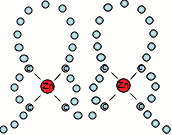
LIM domain
Encyclopedia
LIM domains are protein
structural domains, composed of two contiguous zinc finger
domains, separated by a two-amino acid
residue hydrophobic linker. They are named after their initial discovery in the proteins Lin11, Isl-1 & Mec-3. LIM-domain containing proteins have been shown to play roles in cytoskeletal
organisation, organ development and oncogenesis. LIM-domains mediate protein:protein interactions that are critical to cellular processes.
LIM domains have highly divergent sequences, apart from certain key residues. The sequence divergence allow a great many different binding sites to be grafted onto the same basic domain. The conserved residues are those involved in zinc
binding or the hydrophobic core of the protein. The sequence signature of LIM domains is as follows:
[C]-[X]2-4-[C]-[X]13-19-[W]-[H]-[X]2-4-[C]-[F]-[LVI]-[C]-[X]2-4-[C]-[X]13-20-C-[X]2-4-[C]
 LIM domains frequently occur in multiples, as seen in proteins such as TES
LIM domains frequently occur in multiples, as seen in proteins such as TES
, LMO4, and can also be attached to other domains in order to confer a binding or targeting function upon them, such as LIM-kinase.
LIM domains are also found in various bacterial lineages where they are typically fused to a metallopeptidase domain. Some versions show fusions to an inactive P-loop NTPase at their N-terminus and a single transmembrane helix. These domain fusions suggest that the prokaryotic LIM domains are likely to regulate protein processing at the cell membrane. The domain architectural syntax is remarkable parallel to those of the prokaryotic versions of the B-box zinc finger
and the AN1 zinc finger
domains.
Protein
Proteins are biochemical compounds consisting of one or more polypeptides typically folded into a globular or fibrous form, facilitating a biological function. A polypeptide is a single linear polymer chain of amino acids bonded together by peptide bonds between the carboxyl and amino groups of...
structural domains, composed of two contiguous zinc finger
Zinc finger
Zinc fingers are small protein structural motifs that can coordinate one or more zinc ions to help stabilize their folds. They can be classified into several different structural families and typically function as interaction modules that bind DNA, RNA, proteins, or small molecules...
domains, separated by a two-amino acid
Amino acid
Amino acids are molecules containing an amine group, a carboxylic acid group and a side-chain that varies between different amino acids. The key elements of an amino acid are carbon, hydrogen, oxygen, and nitrogen...
residue hydrophobic linker. They are named after their initial discovery in the proteins Lin11, Isl-1 & Mec-3. LIM-domain containing proteins have been shown to play roles in cytoskeletal
Cytoskeleton
The cytoskeleton is a cellular "scaffolding" or "skeleton" contained within a cell's cytoplasm and is made out of protein. The cytoskeleton is present in all cells; it was once thought to be unique to eukaryotes, but recent research has identified the prokaryotic cytoskeleton...
organisation, organ development and oncogenesis. LIM-domains mediate protein:protein interactions that are critical to cellular processes.
LIM domains have highly divergent sequences, apart from certain key residues. The sequence divergence allow a great many different binding sites to be grafted onto the same basic domain. The conserved residues are those involved in zinc
Zinc
Zinc , or spelter , is a metallic chemical element; it has the symbol Zn and atomic number 30. It is the first element in group 12 of the periodic table. Zinc is, in some respects, chemically similar to magnesium, because its ion is of similar size and its only common oxidation state is +2...
binding or the hydrophobic core of the protein. The sequence signature of LIM domains is as follows:
[C]-[X]2-4-[C]-[X]13-19-[W]-[H]-[X]2-4-[C]-[F]-[LVI]-[C]-[X]2-4-[C]-[X]13-20-C-[X]2-4-[C]

TES (protein)
Testin also known as TESS is a protein that in humans is encoded by the TES gene located on chromosome 7. TES is a 47 kDa protein composed of 421 amino acids found at focal adhesions and is thought to have a role in regulation of cell motility. In addition to this, TES functions as a tumour...
, LMO4, and can also be attached to other domains in order to confer a binding or targeting function upon them, such as LIM-kinase.
LIM domains are also found in various bacterial lineages where they are typically fused to a metallopeptidase domain. Some versions show fusions to an inactive P-loop NTPase at their N-terminus and a single transmembrane helix. These domain fusions suggest that the prokaryotic LIM domains are likely to regulate protein processing at the cell membrane. The domain architectural syntax is remarkable parallel to those of the prokaryotic versions of the B-box zinc finger
B-box zinc finger
In molecular biology the B-box-type zinc finger domain is a short protein domain of around 40 amino acid residues in length. B-box zinc fingers can be divided into two groups, where types 1 and 2 B-box domains differ in their consensus sequence and in the spacing of the 7-8 zinc-binding residues...
and the AN1 zinc finger
AN1 zinc finger
In molecular biology, the AN1-type zinc finger domain, which has a dimetal -bound alpha/beta fold. This domain was first identified as a zinc finger at the C terminus of AN1 , a ubiquitin-like protein in Xenopus laevis...
domains.

